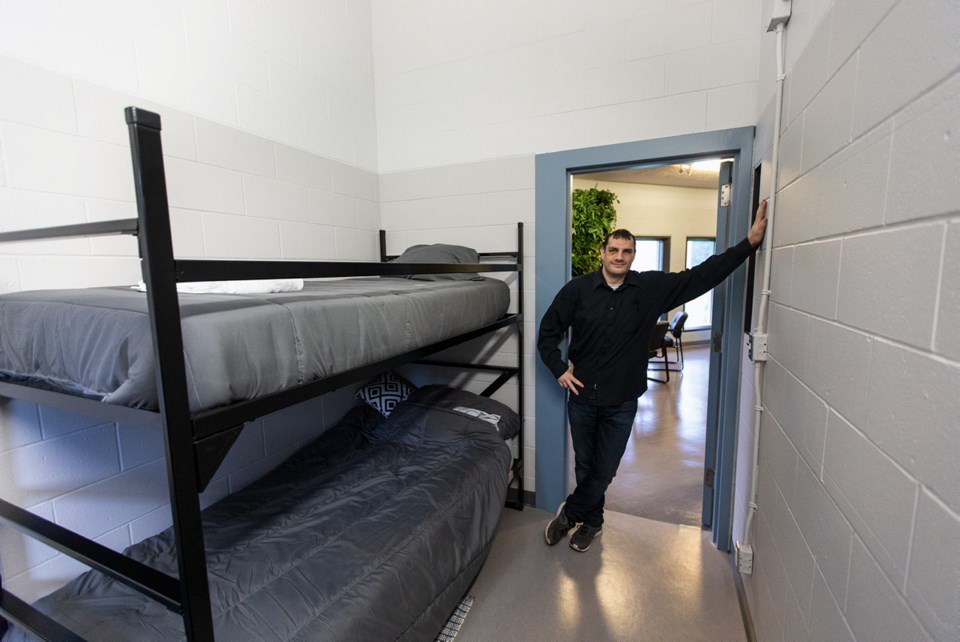Dwayne Lacey has been desperately trying to free himself from the addiction that’s left him locked in a cycle of homelessness and crime.
In the past, Lacey searched for long-term recovery options, but found that many were expensive and not publicly funded.
Lacey is one of the first clients of a new therapeutic recovery community that officially opened in View Royal on Friday.
The program is housed in a Talcott Road building that previously operated as a youth detention facility, then a shelter housing former residents of the tent city at the Victoria courthouse.
The recovery centre currently only has two residents, but within a year, it’s expected to house 50 men who have lived on the streets, been in jail or struggled with addiction.
It will be run by Our Place Society and staffed around-the-clock by a clinical team made up of a physician, psychiatrist, nurses and clinical counsellors.
Residents will stay between 14 and 24 months, depending on the progress of their recovery.
“I’m really thankful that this place is free,” said Lacey, who has lived on Vancouver’s Downtown Eastside and seen many friends fatally overdose.
“I just need it in my life because I’ve done lots of bad, like drugs and in and out of jail, and I just need this time to reflect on myself and change my drug habit.”
Don Evans, executive director of Our Place Society, has seen many clients of the Pandora Avenue drop-in centre caught in the revolving door of jail, drugs and the streets. He has long been frustrated by the severe shortage of long-term, government-funded recovery programs, which is why he spent years championing the project and pushing for government help.
The Ministry of Mental Health and Addictions stepped up with $4.7 million to fund the Talcott Road centre, while B.C. Housing paid $310,000 for renovations, provided a $1-a-year lease and will cover the property taxes for three years.
Minister of Mental Health and Addictions Judy Darcy said the government will closely watch the success of the program before deciding whether to fund other recovery centres across the province.
Ryan L’Hirondelle is living proof of the success of similar programs. Now one of the community’s peer-support workers, L’Hirondelle shared his story of recovery at Guthrie House, a therapeutic recovery program at the Nanaimo Correctional Centre. L’Hirondelle admits that when he first entered the program in 2008, it was rather half-heartedly. He stayed only four months, which he later learned is when the real work starts.
He was released from incarceration and lasted four days before committing another offence. The next time, he got further. He was in the program for 10 months before he was released again.
He was out for six months, but still hadn’t fully managed his addiction to pharmaceutical drugs. He committed another offence, but this time, he turned himself in, even with the knowledge that he would be facing considerable jail time.
“I knew that was the right thing to do,” said the 34-year-old, who wears his hair slicked in a mohawk and has a sparrow tattoo on the left side of his neck.
In his third time in the program, L’Hirondelle said, he was fully on board.
“I made a commitment to myself and others that I would buy in and never look back,” he said.
With the help of his mentors, he stopped taking the medication that had been a crutch for so long.
L’Hirondelle was doing so well, he was given the chance to participate in a pilot project that would allow him unescorted absences to take classes at Vancouver Island University.
“I was told: ‘This is a pilot project, so don’t mess it up,’ ” he quipped.
Now, L’Hirondelle, who is Métis from northern Alberta, has a bachelor of arts in First Nations studies.
“I get to do a convocation in February with the gown and the little hat,” he said.
Just before he took the podium to speak to the media and dignitaries gathered at the grand opening in View Royal, L’Hirondelle remembered something he wrote down in a notebook when he was in the middle of the program.
The note said: “I’m a success story waiting to be told.”
“That moment has come,” he told the crowd.
L’Hirondelle cut the ribbon for the new centre, alongside Darcy, Evans and members of the Tsartlip First Nation. The First Nation will work with the community to build a sweat lodge and develop culturally sensitive programs for Indigenous clients.
In a program modelled on the San Patrignano Therapeutic Community in Italy, clients will be responsible for cooking their own meals, growing their own food, cleaning and helping with building renovations. They will also learn vocational skills such as catering and woodworking.
Efforts have already been made to make the former detention facility feel like a home for the residents. The walls are decorated with art on loan from the Art Gallery of Greater Victoria and the space is filled with greenery. The centre has an industrial-sized kitchen where the men will learn to cook, a gymnasium, games room and books scattered on the tables.
The rooms are fitted with bunk beds. In Lacey’s room, he has a few personal items lined up neatly on a brown shelf.
Clients will be referred through three streams: the court system, as an alternative to jail; B.C. Corrections for those finishing their sentences; and Island Health, for homeless people who have gone through detox programs.
“People come here because they are ready to change,” Darcy said. “They have tried to find a pathway to hope, but very often on their own. I’ve talked to so many people who have tried so many different ways to find their path into the light. This community provides an all-hands-on-deck approach to finding that pathway.
“People will not be alone.”



